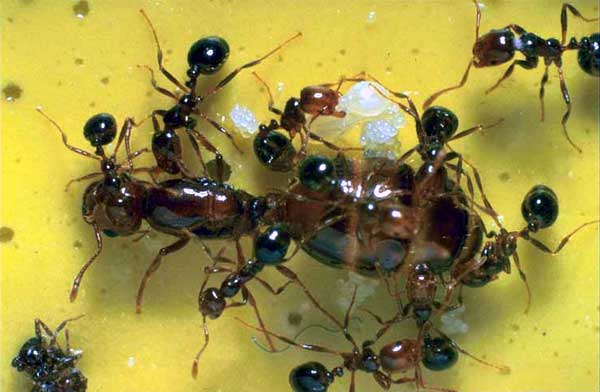
AntWatch Biology Center

Ants have very complex and varied biology. However, all ants are true social insects. Other true social insects include social bees, social wasps, and termites. This means they live in colonies, with only one or several individuals that can reproduce, or lay eggs, and many sterile worker individuals. This social organization means an ant colony works together for the common goal of colony growth and reproduction. Social ants can hunt and subdue prey together, recruit nestmates to a rich food source, cultivate and care for the brood, among other functions. View the colony cycle seen in many ant species.
If there are so many advantages to being social, why didn’t other insects evolve sociality? It is very difficult to answer “why” questions in biology, especially evolutionary biology. Sociality evolved in these specific groups and no others, but we cannot know why it did not in other groups. Evolution proceeds largely by chance. A genetic mutation occurs by chance. Most mutations are harmful or neutral. If a mutation encodes a favorable change, individuals may grow or reproduce better or more quickly than individuals without the trait, thus favoring that trait in the population. Coming soon: an activity demonstrating this mechanism of natural selection using jelly beans. There are over 10,000 species of ants, many of which have evolved extraordinarily diverse life strategies. Among the more famous are army ants, leafcutter ants, driver ants, weaver ants, and slave-making ants. Ants can form tight mutualisms with other species, both plant and animal. Many ants will tend leaf-feeding insects, such as aphids or scale insects, for their sweet, carbohydrate-rich secretions. Ants gain food and energy, and the plant-feeding insects gain the formidable protection of ants against other predators. Ants have also developed tight relationships with plants, such that neither organism survives as well in the absence of the other. Ants protect the plants from browsers or feeding insects, and the plants provide a place to live and even produce protein or sugary food bodies. In all of these relationships, the participant species are mutually beneficial to each other. Ants are found on every continent except Antarctica, and are thought to make up about 10% of all animal biological mass worldwide. In the Amazon rainforest, ants are an even larger component, making up almost one-third of the animal biomass. Yet there are no native species of ants in the Hawaiian Islands, nor any social insects of any kind! Based on these data on the importance of ants in worldwide ecosystems, what would you predict might happen when ants colonized Hawai`i? Yes, ants have had dramatic impacts on other insects in Hawai`i. Native insects have evolved in the absence of ants, and thus many have lost their genetically-based, instinctual defensive behaviors that would minimize their impact. Introduced ants have probably caused many extinctions in Hawai`i, with the potential for more, but it is extraordinarily difficult to document and prove an extinction taking place! On this site, view instructions for how to collect ants from your schoolyard or residence, view some pictures of common ants in Hawai`i, and learn how to identify several species using keys. |
|
overview | biology | identification | curricula | mapping | participate | links | site map | home Biology Center | Ant Biology | Ants In Hawaii | Monitoring | Collecting | Identificatioin | Biology Links Website Production by Blu Forman |
